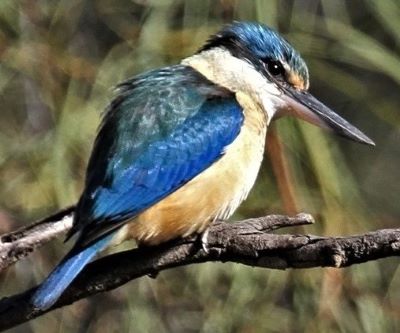As the length of days and nights become even and warmer temperatures are felt in Porneet season on Wurundjeri Woi-wurrung Country, you could be lucky enough to see a Sacred Kingfisher show itself along the Merri Creek as it hunts for grasshoppers, crickets, beetles, frogs, yabbies, and skinks amongst the grasses and bushes of the Merri Creek and surrounds.

Porneet is a way of understanding Wurundjeri Woi-wurrung seasons locally through natural cues such as the emergence of tadpoles, as well as frogs like Eastern Froglets and Growling Grass Frogs. Unlike the Western calendar, which ties four seasons to four times of the year rather than places, the Wurundjeri Woi-wurrung interpretation of seasons lets us observe specific local shifts and signs that are particular to Wurundjeri Country where we are. Seven seasons are able to be recognised through these seasonal changes, and during September and October, signs of Porneet appear.
These signs include increased insect activity, reptiles like skinks begin to move around, the changing vegetation and changing plumage of birds respond to the warmer temperatures: clematis are going to seed, tree violets, which are excellent habitat for birds and Swamp Wallabies, burst out in sweet-scented tiny yellow-green flowers, and the wattle trees are beginning to flower.
In Porneet you may also observe the arrival of migratory birds like Kingfishers, Rufous Songlarks, and White-winged Trillers returning south for the breeding season, busying themselves building nests. Tawny Frogmouths are also readily observed mating, preparing nests and then attending to feeding their young who will fledge by Porneet's end.
Despite being small birds, (20cm long), Sacred Kingfishers fly long distances from Indonesia, Timor, and New Guinea before arriving along the Merri Creek and other open woodland habitat to breed and raise their young during Porneet and Buath Garru.
As well as insects, Sacred Kingfishers enjoy a diet of aquatic macroinvertebrates (including waterbugs like Dragonfly and Damselfly Nymphs) scooped from wetlands, creeks and rivers using their long beaks. The health and diversity of waterbug populations in waterways depend on the quality of that water, which is why the work of the many Waterwatch groups we support at MCMC, is important for many species that feed on waterbugs, including Sacred Kingfishers.
Click here if you'd like to help care for birds like Sacred Kingfishes by volunteering in our WaterWatch program. And remember – if you want to spot a Sacred Kingfisher, you’ll need to be patient! Be prepared to sit quietly (perhaps for a long time!) listening for their distinctive call and watching for a flash of turquoise as they fly between their nests and riverbanks capturing food to feed their new young. They are mainly observed in the warmer months, but sightings have been made as early as October, at the end of Porneet season.





 Merri Creek Management Committee. 2 Lee St, East Brunswick, Victoria, Australia 3057
Merri Creek Management Committee. 2 Lee St, East Brunswick, Victoria, Australia 3057